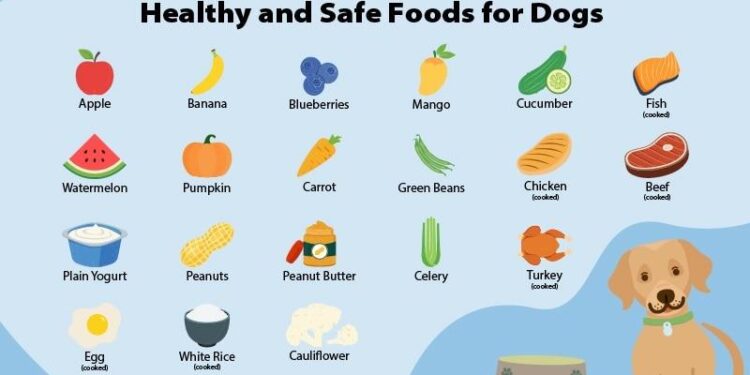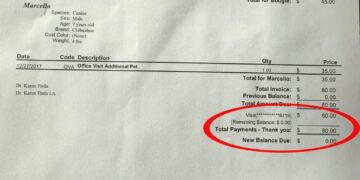Table of Contents
For ten years, my life has revolved around dogs.
I’m not a veterinarian or a credentialed nutritionist, but something else entirely: a dog owner whose love for one particular dog pushed me to the brink of my knowledge and then forced me to build a new foundation, one scientific paper and sleepless night at a time.
This is the story of how I stopped being a confused consumer and became a confident advocate for my dogs’ health.
It’s the story of my best friend, Buster.
Buster was a whirlwind of goofy energy and unconditional love, but his body was a constant source of worry.
Despite my best efforts, he was chronically unwell.
His coat, which should have been a glossy black, was dull, brittle, and flecked with dandruff.1
He suffered from persistent digestive issues—gurgling sounds from his gut, noxious gas, and inconsistent, often loose stools that made every walk a game of chance.2
His ears had a constant, yeasty smell, and his energy would peak and crash, leaving him lethargic when he should have been chasing squirrels.
The heartbreak wasn’t in the symptoms themselves, but in the feeling of utter helplessness.
I was doing everything “right.” I was a diligent student of the pet food world, spending hours on blogs and forums.
I bought the bags with the five-star ratings, the ones that screamed “premium,” “holistic,” and “natural”.4
I made sure a recognizable meat was the first ingredient.
I paid a premium for these foods, believing the price tag was a proxy for quality.
Yet, Buster remained unwell.
We were trapped in a frustrating cycle: a trip to the vet, a course of antibiotics or antifungals, a temporary improvement, and then, inevitably, a relapse.
I felt like I was failing him, pouring love, effort, and a small fortune into a system that was delivering nothing but disappointment.
My breaking point came in the form of a beautifully designed, incredibly expensive bag of kibble.
The grain-free movement was at its peak, and the marketing was seductive.
Grains, I was told, were “cheap fillers,” unnatural for dogs, and the root cause of allergies.6
Convinced this was the answer I’d been searching for, I switched Buster to a boutique, grain-free formula featuring an exotic protein—bison and lentils.
I was filled with hope.
This, I thought, was the holy grail.
The result was a catastrophe.
Within a week, Buster’s chronic digestive upset exploded into full-blown, watery diarrhea.2
He became listless, lost weight, and looked miserable.
An emergency vet visit and a course of medication stabilized him, but the experience shattered my confidence.
I had followed the most popular, “expert” advice to the letter, and it had made my dog violently Ill. That night, looking at Buster curled up and weak, I had a revelation: the entire framework I was using to judge dog food was fundamentally, dangerously flawed.
I had been so focused on what was being
excluded from his food—the grains—that I had no real understanding of what was actually in it, or, more importantly, what his body could do with it.
I had to throw out everything I thought I knew and start from scratch.
The Ingredient List Illusion: Deconstructing the Myths I Believed
My first step was to perform a forensic analysis of my own beliefs.
I had been operating under a set of rules I’d absorbed from marketing, packaging, and online communities.
I realized these rules weren’t just wrong; they were illusions, cleverly constructed to guide me toward a purchase, not toward my dog’s actual health.
The Flaw of “First Ingredient” Thinking
The most pervasive rule I followed was to judge a food by its first five ingredients.
The mantra was simple: “Look for a whole meat as the number one ingredient.” It sounds logical, but it’s one of the most effective marketing tricks in the industry.
The deception lies in a simple, regulated detail: ingredients must be listed in descending order by their pre-processing weight, and that weight includes water.7
Consider the classic example: a bag that lists “Chicken” as its first ingredient, followed by “Chicken Meal” in the third or fourth position.
To the consumer, this looks fantastic.
“Real chicken” is the star.
But “real chicken” is about 70-75% water.8
“Chicken meal,” on the other hand, is chicken that has been rendered—a process of cooking that removes the water and fat, creating a concentrated protein powder with only about 10% moisture.9
When that bag of kibble goes through the high-heat cooking and extrusion process, the water in the “real chicken” is cooked off.
Its weight plummets, and its actual contribution to the final product’s protein content becomes significantly less than that of the dry, concentrated chicken meal.9
A food with chicken meal as the first ingredient is often providing far more animal protein than one that uses label-friendly “real chicken” to secure the top spot.
I realized the ingredient list wasn’t a transparent window into the food’s composition; it was a carefully curated billboard designed to appeal to my human sensibilities.7
Debunking the “Filler” Fallacy
The marketing that led me to the disastrous grain-free experiment was built on another powerful myth: the idea that grains like corn and wheat are nothing more than “cheap fillers.” A “filler” is technically an ingredient that provides no nutritional value.5
This is demonstrably false for grains.
From a veterinary and nutritional science perspective, properly cooked grains are highly digestible for the vast majority of dogs—often with over 90% efficiency.6
Domestication has equipped dogs with the necessary enzymes, like amylase, to effectively process starches.5
Far from being empty calories, whole grains contribute valuable and sustained energy from complex carbohydrates, fiber for gastrointestinal health, essential fatty acids, vitamins, and minerals.6
The truth about grain allergies is also wildly distorted by marketing.
While food allergies in dogs do exist, they are far less common than environmental allergies.
Furthermore, when a food allergy is identified, the culprit is overwhelmingly a protein source.
Studies have consistently shown the most common canine food allergens to be beef, dairy, and chicken.
Wheat ranks fourth, responsible for only about 13% of cases.5
The idea that millions of dogs require a grain-free diet is a marketing invention, not a medical reality.
The Ambiguity of Quality
My investigation also revealed that even when I could identify an ingredient, I had no real way of knowing its quality.
Take the term “animal by-products.” It sounds unappealing, and it’s often demonized as a sign of a low-quality food.12
However, the official definition includes highly nutritious organ meats like liver, kidneys, and spleen—parts of an animal that are often far more nutrient-dense than the simple muscle meat humans prefer.12
A food containing “chicken by-products” could be providing a rich, diverse profile of nutrients.
Conversely, an ingredient that sounds pristine, like “beef,” tells you nothing about its origin.
Was it from grass-fed cattle, rich in beneficial fatty acids, or from a lower-quality source?.15
What about an ingredient as vague as “animal fat”? This is a rendered product that, according to AAFCO definitions, can be sourced from any combination of mammals or poultry, with no requirement to disclose the origin.16
It could be a high-quality fat, or it could be a rendered product from diseased animals.16
The label gives you no way to tell.
The Grain-Free Rabbit Hole and the DCM Scare
My personal disaster with the grain-free diet turned out to be a microcosm of a much larger, more alarming industry issue.
In 2018, the U.S. Food and Drug Administration (FDA) announced it was investigating a potential link between certain diets—many of them labeled “grain-free”—and a serious, often fatal heart condition called dilated cardiomyopathy (DCM) in dog breeds not typically prone to the disease.17
The investigation noted that the diets most frequently associated with these cases often contained high levels of legumes like peas and lentils, or potatoes, as their primary carbohydrate sources—the very ingredients that had replaced grains in the food I gave Buster.17
The issue wasn’t necessarily the
absence of grain, but the nutritional consequences of what it was being replaced with.
These new formulations, heavily reliant on novel ingredients, may have interfered with the absorption of critical nutrients like taurine or created other unforeseen nutritional imbalances.18
This news was a chilling validation of my experience.
I had been drawn into a marketing trend that was not only based on a faulty premise but was also potentially implicated in a serious health crisis.
It solidified my conviction that I was looking at the problem entirely the wrong Way. The secret to my dog’s health wasn’t going to be found on the front of the bag or in the ingredient list.
I needed a whole new system.
The Epiphany: A Lesson from Elite Athletes
My search for a new framework led me, unexpectedly, to the world of human sports nutrition.
In my desperation to understand what was happening inside Buster’s body, I started reading about how elite athletes fuel theirs.
It was here, in the science of maximizing human performance, that I had my epiphany.
For a marathon runner or a professional weightlifter, nutrition is not a simple list of foods.
It is a complex, dynamic system governed by a single, overriding principle: usability.
I learned that for an athlete, it’s not just about eating 30 grams of protein; it’s about consuming a type of protein, like whey isolate, that can be absorbed rapidly by the muscles during the critical post-workout recovery window.19
It’s not just about eating carbohydrates; it’s about the
timing of those carbs to ensure muscle glycogen stores are full before a competition.20
An athlete would never eat a large steak and a fibrous salad ten minutes before a race.
Why? Because while the steak contains high-quality protein and the salad is full of vitamins, their nutrients are not in a form that is immediately accessible to the body.
The energy required to digest them would divert resources from the muscles, hindering performance.22
In that moment, the nutrients in the steak are not
usable.
They are not bioavailable.
And there it was.
The word that changed everything.
I dove into the scientific literature and found a clear definition.
Bioavailability is “the proportion of a nutrient that is digested, absorbed, and ultimately available for biological activity in your cells and tissues”.2
It’s not about what’s in the food; it’s about what the body can actually
get out of the food.
A food’s digestibility is the first step, measuring what portion of nutrients can be absorbed from the intestine into the bloodstream.
Bioavailability goes further, measuring the proportion of those absorbed nutrients that are actually carried to the target tissues and are available for use.2
Suddenly, Buster’s entire health history snapped into focus.
The expensive, “premium” kibble I was feeding him was the nutritional equivalent of that pre-race steak.
The bag’s guaranteed analysis promised a certain percentage of protein, fat, and minerals.
The ingredient list showed all the right things.
But the nutrients were locked away in a form that his body couldn’t efficiently access.
They were present, but they weren’t bioavailable.
The problem wasn’t a single ingredient.
It was the food’s fundamental inability to deliver on its promises at a cellular level.
His body was working overtime, struggling to extract nourishment from a highly processed, denatured product, and the chronic inflammation, digestive distress, and poor coat were the direct results of that struggle.3
I had been judging food like an accountant, tallying up the nutrients on a spreadsheet.
I needed to start thinking like a biologist, considering the complex journey those nutrients take from the bowl to the cell.
This new paradigm—the Bioavailability Blueprint—became my guide.
The Bioavailability Blueprint: A New System for Judging Dog Food
Armed with this new understanding, I began to see dog food not as a static list of ingredients, but as a dynamic system.
The true nutritional value of a food, I realized, is determined by a chain of factors, and a weakness in any link can compromise the entire chain.
I organized my thinking into two core pillars: the quality of the raw materials and the impact of the manufacturing process.
Pillar I: The Raw Materials — Form Dictates Function
The bioavailability of a nutrient begins with its source and its form.
The body is designed to recognize and utilize nutrients as they appear in nature, within a complex structure of complementary compounds.
When we isolate, alter, or substitute these forms, we can dramatically reduce their usability.
Whole Foods vs. Rendered Products
This brought me back to the chicken versus chicken meal debate, but with a new layer of sophistication.
While chicken meal is undeniably more protein-dense, the rendering process it undergoes involves high heat, which can alter the structure of its proteins.28
The quality of that process, and the quality of the chicken that went into it, are complete unknowns to the consumer.
Minimally processed, whole-food ingredients, like lightly cooked chicken or beef, offer a different advantage.
They deliver nutrients within what scientists call the “whole food matrix”.29
This means the proteins, fats, vitamins, and minerals are present alongside countless other micronutrients and enzymes in the form the body evolved to digest.
For example, research has shown that natural vitamin E from whole foods is absorbed more than twice as effectively as its synthetic counterpart, even when the molecular structures are identical.30
By prioritizing whole, minimally processed ingredients, I could provide Buster’s body with nutrients in their most recognizable and usable form.
The Mineral Problem: Chelated vs. Inorganic
One of my biggest “aha!” moments came when I looked at the mineral list on Buster’s old kibble bags.
I saw names like “copper sulfate,” “zinc oxide,” and “manganese sulfate.” These are inorganic mineral salts, the cheapest and most common forms used in pet food.
The problem is that these inorganic minerals are highly reactive in the digestive tract and are notoriously difficult for the body to absorb.31
They can easily bind with other compounds in the food, such as phytates from plants, and pass through the body completely unused, excreted as waste.31
Then I discovered chelated minerals.
Chelation is a process where a mineral is chemically bonded to an organic molecule, typically an amino acid (the building blocks of protein).33
This process creates a protective bubble around the mineral, preventing it from binding with other substances in the gut.
The body, recognizing the amino acid, readily transports the entire compound across the intestinal wall, delivering the mineral with far greater efficiency.34
You can spot them on an ingredient list by names like “zinc proteinate,” “iron glycinate,” or “copper chelate”.33
Their presence is one of the clearest indicators that a manufacturer is prioritizing bioavailability over cost.
Studies show that chelated minerals can be 5 to 15 percent more bioavailable than their inorganic counterparts, and while they can cost more than five times as much to include, the nutritional payoff is enormous.33
For a dog with a compromised digestive system like Buster, ensuring he could actually absorb these critical trace minerals was a game-changer.
Fats and Fibers: Quality Over Quantity
The same principle applies to fats and fibers.
The label might say “15% fat,” but the type of fat matters immensely.
Many commercial foods use a generic ingredient called “animal fat,” a rendered product of unknown origin that can be high in pro-inflammatory omega-6 fatty acids.16
A high-bioavailability diet, in contrast, will use a named, high-quality fat source like “salmon oil” or “flaxseed oil,” which are rich in anti-inflammatory omega-3 fatty acids like EPA and DHA that support skin, coat, and joint health.1
Similarly, fiber is crucial for digestive health, but its source is key.
Low-quality foods often use cheap, non-nutritive fiber sources like “powdered cellulose”—which is essentially wood pulp—or beet pulp.16
While these add bulk to the stool, they offer little else.
High-bioavailability sources like pumpkin, sweet potatoes, or cooked green beans provide both soluble and insoluble fiber that nourishes the gut microbiome and supports consistent digestion, all while contributing additional vitamins and antioxidants.16
To make this practical, I developed a simple chart to help me categorize ingredients at a glance.
| Nutrient Type | High Bioavailability Sources (What to Look For) | Low Bioavailability Sources (Red Flags) |
| Protein | Lightly cooked, named muscle & organ meat (e.g., Beef, Beef Liver), named fish, high-quality named meal (e.g., Chicken Meal) | Unspecified “Meat Meal” or “Animal By-Products”, heat-denatured proteins from harsh processing |
| Minerals | Chelated minerals (e.g., Zinc Proteinate, Copper Chelate), minerals from whole food sources (e.g., liver for iron) | Inorganic mineral salts (e.g., Copper Sulfate, Zinc Oxide), un-supplemented diets relying on poor sources |
| Fats | Named fish oil (e.g., Salmon Oil, Sardine Oil), flaxseed oil, coconut oil | Unspecified “Animal Fat”, rendered fats, vegetable oils like corn or soy oil 16 |
| Fiber | Pumpkin, sweet potato, squash, cooked leafy greens (e.g., spinach), apple slices | Powdered cellulose, beet pulp, grain hulls (e.g., rice bran) 16 |
This spectrum thinking moved me beyond the binary of “good” vs. “bad” ingredients and gave me a more nuanced way to evaluate the potential of a food’s raw materials.
But that was only half the battle.
What happens to those ingredients in the “kitchen” was the next critical piece of the puzzle.
Pillar II: The Kitchen — How Processing Destroys Potential
Even the highest-quality, most bioavailable ingredients in the world can be rendered nutritionally useless by a destructive manufacturing process.
I learned that the standard method for making dry kibble, called extrusion, is a marvel of industrial efficiency that prioritizes shelf-stability and cost over nutritional integrity.
It is a fundamentally violent process.
The Violence of Extrusion
During extrusion, a dough of mixed ingredients is forced through a machine where it is subjected to extreme heat—often as high as 275°F—and immense pressure.36
This process cooks the starches, sterilizes the mixture, and shapes it into the familiar kibble pellets before it is dried and sprayed with fats and flavor enhancers.38
This intense processing doesn’t just cook the food; it fundamentally denatures it.
Heat-sensitive vitamins, particularly B-group vitamins and vitamins A, C, and E, are significantly degraded or destroyed entirely.36
Natural enzymes present in the whole food ingredients, which would normally aid in digestion, are inactivated.37
Fragile, beneficial fats like omega-3s are prone to oxidation, turning them from anti-inflammatory to potentially pro-inflammatory.36
This is precisely why extruded kibble bags have a long list of synthetic vitamins and minerals added back in.
They are replacing the nutrients that the manufacturing process itself obliterated.36
The Maillard Reaction: A Hidden Danger
Digging deeper, I discovered a more insidious consequence of this high-heat processing: the Maillard reaction.
This is a chemical reaction between amino acids and sugars that occurs during cooking, responsible for the browning and flavor development in everything from seared steak to toasted bread.39
In pet food manufacturing, however, it has a dark side.
The reaction can bind essential amino acids, particularly lysine, making them unavailable for absorption by the dog’s body.39
So even if the food contained adequate lysine on paper, a significant portion of it could be biologically useless.
This means a dog eating this food could be in a state of amino acid deficiency, even while consuming a “high-protein” diet.
Even more alarming is that the Maillard reaction can create potentially toxic compounds, such as acrylamide and advanced glycation end products (AGEs).36
These substances have been linked in human and animal studies to a host of health issues, including inflammation, oxidative stress, and even cancer.36
It’s highly likely that the continuous ingestion of these compounds from his “premium” kibble was a major factor contributing to Buster’s chronic inflammation and poor health.
Alternative Processing Methods
The good news is that less destructive methods exist.
Baking at lower temperatures can preserve more nutrients than extrusion.28
Dehydration and air-drying use low heat over a longer period, which is gentler on vitamins and enzymes.37
The gold standard for preserving nutritional integrity is
freeze-drying, a process that removes moisture without using heat at all, leaving the nutrients in their original state.37
These methods are more expensive and time-consuming, which is why they are less common, but they result in a final product with vastly superior bioavailability.
The realization was stark: the vast majority of commercial dog food is produced using a method that is fundamentally at odds with the goal of delivering high-quality nutrition.
The process is designed for the convenience of the manufacturer and the consumer—long shelf life, easy storage—but it comes at a steep biological cost to the dog.
Building the Bioavailable Bowl: A Practical Guide
Putting all the pieces of the Bioavailability Blueprint together, I made a radical change.
I threw out the kibble for good.
I started preparing Buster’s food myself, using a recipe formulated with a veterinary nutritionist that was built on these principles: whole, human-grade meats and organs, vibrant vegetables, and supplemental high-quality fish oil and chelated minerals.
The food was gently cooked at a low temperature, just enough to ensure safety while preserving the integrity of the nutrients.
The transformation was nothing short of miraculous.
Within two weeks, his stools became consistently firm and well-formed.
The gurgling in his stomach ceased.
Within a month, his coat started to change.
The dull, brittle fur was replaced by a deep, glossy black sheen.
The yeasty smell in his ears vanished.
But the most profound change was in his demeanor.
His energy returned, not in frantic bursts, but with a steady, joyful vitality.
The playful, happy-go-lucky dog I knew was back.
He was living proof that when the body is given nutrients it can actually use, it has a remarkable capacity to heal itself.
I know that home-cooking isn’t a realistic option for everyone.
But the Bioavailability Blueprint isn’t about a single method; it’s a new lens through which to evaluate any food you choose to buy.
It’s about becoming a detective for your dog’s health.
Becoming a Label Detective
Here is the practical, step-by-step audit I now use when looking at any dog food:
- Look Beyond the First Five: Read the entire ingredient list. Scan for red flags that can appear further down, like unspecified “meat” or “animal fat,” which signal low-quality sourcing.16
- Check the Mineral List: This is your secret weapon. Go to the end of the ingredient list where the vitamin and mineral supplements are. Are the minerals listed as sulfates and oxides (e.g., “zinc sulfate”)? Or are they proteinates and chelates (e.g., “zinc proteinate”)? The presence of at least a few chelated minerals is a powerful indicator that the company invests in bioavailability.33
- Identify the Carbohydrates and Fibers: Are the carbs coming from whole foods like sweet potato or squash? Or is the list heavy with legumes like peas, lentils, and chickpeas high up in the first few ingredients? Given the ongoing DCM concerns, heavy reliance on these ingredients is a reason for caution.17 Is the fiber from pumpkin or from “powdered cellulose”?.16
- Infer the Processing Method: The packaging will give you clues. Is it a hard, dry pellet with a shelf life of over a year? That’s almost certainly extruded. Look for explicit claims on the bag like “slow-baked,” “air-dried,” “dehydrated,” or “freeze-dried.” These signal a gentler process designed to preserve nutrients.28
Questions for the Manufacturer
The label will only tell you so much.
A truly transparent company will be able to answer more detailed questions.
Don’t be afraid to call or email them and ask:
- “What cooking process do you use, and what are the maximum temperatures the ingredients are exposed to?”
- “Can you provide the ‘digestibility coefficient’ or ‘Total Tract Digestibility’ percentage for your food?” (High-quality foods should be over 82%, with exceptional foods over 88% digestible 4). Reputable companies conduct these feeding trials but often don’t publish the results unless asked.2
- “Can you tell me the specific source of the ‘chicken meal’ or ‘animal fat’ in this formula?”
Their willingness—or unwillingness—to answer these questions will tell you a great deal about their commitment to quality versus marketing.
To simplify this process, I created a checklist to “score” any food I’m considering.
| The Bioavailability Audit Checklist | Response |
| 1. Protein Quality: Is the primary protein source a named animal (e.g., “Beef,” not “Meat”)? | Y / N |
| 2. Nutrient Diversity: Are named organ meats (e.g., “Beef Liver”) included in the first 10 ingredients? | Y / N |
| 3. Fat Quality: Are all fats from a named, high-quality source (e.g., “Salmon Oil,” not “Animal Fat”)? | Y / N |
| 4. Mineral Bioavailability: Does the mineral list include at least three chelated/proteinated minerals? | Y / N |
| 5. Processing Method: Is the food explicitly described as baked, freeze-dried, or gently cooked (not extruded)? | Y / N |
| 6. Carbohydrate Source: Are the primary carbohydrates from whole foods (e.g., sweet potato) instead of high levels of peas/lentils in the first 5 ingredients? | Y / N |
| Total ‘Yes’ Score: | / 6 |
Scoring Key:
- 5-6 Points: High Bioavailability Potential. This food is likely made with high-quality, usable ingredients and a nutrient-preserving process.
- 3-4 Points: Moderate Bioavailability. A decent food, but likely makes some compromises on ingredient form or processing to manage cost.
- 0-2 Points: Low Bioavailability Potential. This is likely a highly processed food prioritizing cost and shelf life over nutritional usability.
This tool isn’t foolproof, but it transforms you from a passive consumer into an active investigator.
It gives you a tangible way to apply the principles of bioavailability and make a confident, evidence-based choice.
Conclusion: From Helpless Owner to Empowered Advocate
Buster’s journey back to health was my own journey from confusion to clarity.
For years, I was a victim of an industry that has perfected the art of appealing to our love for our pets while obscuring the science of what truly nourishes them.
I was looking for a magic ingredient, a silver-bullet food that would solve all our problems.
The answer, I discovered, was not an ingredient at all.
It was a paradigm shift.
It was the realization that a dog’s body, like an elite athlete’s, is a complex biological system that runs on usable nutrients.
The key was to stop reading the marketing story on the front of the bag and start analyzing the biological reality of what happens inside the body.
My hope in sharing this story is to offer you that same paradigm shift.
Stop letting marketing terms like “grain-free” or “holistic” guide your decisions.
Stop being swayed by the first ingredient on the list.
Instead, start thinking like a nutritionist for your own dog.
Use the Bioavailability Blueprint as your guide.
Question the form of the ingredients.
Question the violence of the process.
Demand transparency from the companies you support.
You don’t need to become an amateur nutritionist as I did.
You just need a new framework for asking the right questions.
By focusing on the single, powerful concept of bioavailability, you can cut through the noise and confusion.
You can move beyond the helplessness of trial and error and make clear, confident choices that truly support your dog’s health from the inside O.T. You can become what your dog already thinks you are: their most powerful, knowledgeable, and effective advocate.
Works cited
- Effects Of Poor Nutrition On Dogs: Top 6 Ways It Impacts Health, accessed August 17, 2025, https://dog-house.ae/dog-nutrition/6-poor-nutrition-affect-dogs-health/
- The Importance of Pet Food Digestibility & Palatability – Ray Allen Manufacturing, accessed August 17, 2025, https://www.rayallen.com/blog/the-importance-of-pet-food-digestibility-palatability/
- What Causes Malabsorption in Dogs? – My Pet Nutritionist, accessed August 17, 2025, https://mypetnutritionist.com/post/what-causes-malabsorption-in-dogs/
- All About Pet Food Digestibility – American Kennel Club, accessed August 17, 2025, https://www.akc.org/expert-advice/nutrition/pet-food-digestibility/
- Debunking common pet food myths – Veterinary Practice, accessed August 17, 2025, https://www.veterinary-practice.com/article/debunking-common-pet-food-myths
- Grain-Free Pet Foods: Fact vs Fiction – Quakers Hill Vet Hospital, accessed August 17, 2025, https://www.quakershillvethospital.com.au/pet-health/grain-free-pet-foods-fact-vs-fiction/
- Why you shouldn’t judge a pet food by its ingredient list – Petfoodology – Tufts Sites, accessed August 17, 2025, https://sites.tufts.edu/petfoodology/2016/06/21/why-you-shouldnt-judge-a-pet-food-by-its-ingredient-list/
- What Is Chicken Meal in Dog Food? – Purina, accessed August 17, 2025, https://www.purina.com/articles/dog/health/nutrition/what-is-chicken-meal-in-dog-food
- Chicken Meat vs Chicken Meal: Which is Better for Dogs …, accessed August 17, 2025, https://brothersdogfood.com/blogs/behind-the-bowl/is-chicken-better-than-chicken-meal
- What is Chicken Meal in Dog Food? [Veterinarian Explains] – Bully Max, accessed August 17, 2025, https://shop.bullymax.com/blogs/news/chicken-meal-in-dog-food
- Essential Dog Food Ingredients for Healthy Dogs – American Kennel Club, accessed August 17, 2025, https://www.akc.org/expert-advice/nutrition/essential-dog-food-ingredients-for-healthy-dogs/
- Pet food ingredients: Good, bad and ugly (Proceedings) – DVM360, accessed August 17, 2025, https://www.dvm360.com/view/pet-food-ingredients-good-bad-and-ugly-proceedings
- 5 Essential Nutrients Dogs Need – Wellness Through Nutrition …, accessed August 17, 2025, https://www.parklandanimalclinic.com/post/5-essential-nutrients-dogs-need-wellness-through-nutrition.html
- Effects of different chicken protein sources on palatability in dry adult dog food – Frontiers, accessed August 17, 2025, https://www.frontiersin.org/journals/animal-science/articles/10.3389/fanim.2023.1292658/full
- 19 Healthy and Safe Foods You Can Feed Your Dog – CareCredit, accessed August 17, 2025, https://www.carecredit.com/well-u/pet-care/healthy-food-for-dogs/
- Whole Food Diet for Dogs – BioStar US, accessed August 17, 2025, https://www.biostarus.com/pages/whole-food-diet-for-canines
- The Rise and Fall of Grain-Free Pet Food: What You Should Know in 2025, accessed August 17, 2025, https://transconpet.com/the-rise-and-fall-of-grain-free-pet-food-what-you-should-know-in-2025/
- Grain Free vs. Grain Dog Food: Which One’s Best? | The Vets, accessed August 17, 2025, https://thevets.com/resources/pet-nutrition/grain-free-vs-grain-dog-food/
- The Second Scoop on Protein: When, What and How Much? – NASM Blog, accessed August 17, 2025, https://blog.nasm.org/fitness/the-second-scoop-on-protein-when-what-and-how-much
- What Is Sports Nutrition? Why It Should Matter to Athletes | American Public University, accessed August 17, 2025, https://www.apu.apus.edu/area-of-study/nursing-and-health-sciences/resources/what-is-sports-nutrition/
- Timing It Right – Training & Conditioning, accessed August 17, 2025, https://training-conditioning.com/article/timing-it-right/
- Nutrient Timing: How do I Space Out Meals Around Training?, accessed August 17, 2025, https://www.usada.org/spirit-of-sport/nutrient-timing-around-training/
- Definition of bioavailability from the viewpoint of human nutrition, accessed August 17, 2025, https://www.bfr.bund.de/cm/343/definition-of-bioavailability-from-the-viewpoint-of-human-nutrition.pdf
- What is Bioavailability & Which Vitamins Have the Best Absorption? – BrainMD, accessed August 17, 2025, https://brainmd.com/blog/what-is-bioavailability/
- Bioavailability of bioactive food compounds: a challenging journey …, accessed August 17, 2025, https://pmc.ncbi.nlm.nih.gov/articles/PMC3575927/
- The Importance of Reporting Pet Food Digestibility – NOBL Foods, accessed August 17, 2025, https://noblfoods.com/blogs/published/the-importance-of-reporting-pet-food-digestibility
- Poor Nutrition in Dogs – Symptoms, Causes, Diagnosis, Treatment …, accessed August 17, 2025, https://wagwalking.com/condition/poor-nutrition
- Preventative Nutrition: A New Way To Look At Feeding Your Dog – Crystal Creek, accessed August 17, 2025, https://crystalcreeknatural.com/preventative-nutrition-a-new-way-to-look-at-feeding-your-dog/
- Nutrient Bioavailability in the Human Body – WholisticMatters, accessed August 17, 2025, https://wholisticmatters.com/nutrient-bioavailability/
- Bioavailability and Nutrition – Guides – Big Dog Pet Foods, accessed August 17, 2025, https://www.bigdogpetfoods.com/guides/bioavailability-and-nutrition
- Mineral Chelation: Animal Nutrition & Health – Balchem, accessed August 17, 2025, https://balchem.com/anh/expertise/mineral-chelation/
- Chelated Minerals: Are They Necessary in Dog Food – Wag!, accessed August 17, 2025, https://wagwalking.com/wellness/chelated-minerals-are-they-necessary-in-dog-food
- Chelated Minerals in Dog Food, accessed August 17, 2025, https://www.dogfoodadvisor.com/choosing-dog-food/chelated-minerals-dog-food/
- What are chelated minerals in pet food?, accessed August 17, 2025, https://addictionpet.com/blog/what-are-chelated-minerals-in-pet-food/
- Top 10 Healthiest Human Foods That Dogs Can Eat [Vet-Approved], accessed August 17, 2025, https://www.splootvets.com/post/healthiest-human-foods-dogs-can-eat
- The Impact of Processing on the Nutrient Content of Commercial Pet …, accessed August 17, 2025, https://www.bigdogpetfoods.com/guides/the-impact-of-processing-on-the-nutrient-content-of-commercial-pet-foods
- How Is Dog Food Made? – Dogs Naturally, accessed August 17, 2025, https://www.dogsnaturallymagazine.com/how-is-dog-food-made/
- How Dog Food Kibble Is Made and Its Impact on Nutrition – Elevate Pet Provisions, accessed August 17, 2025, https://elevatepet.com/blogs/news/how-dog-food-kibble-is-made-and-its-impact-on-nutrition
- The Maillard reaction and pet food processing: effects on nutritive value and pet health | Nutrition Research Reviews – Cambridge University Press, accessed August 17, 2025, https://www.cambridge.org/core/journals/nutrition-research-reviews/article/maillard-reaction-and-pet-food-processing-effects-on-nutritive-value-and-pet-health/E085D3648D6A209003AB4D0DB72DB8B2
- To Chelate or Not to Chelate [Minerals]? – Petfoodology – Tufts Sites, accessed August 17, 2025, https://sites.tufts.edu/petfoodology/2021/11/08/chelated-minerals/






